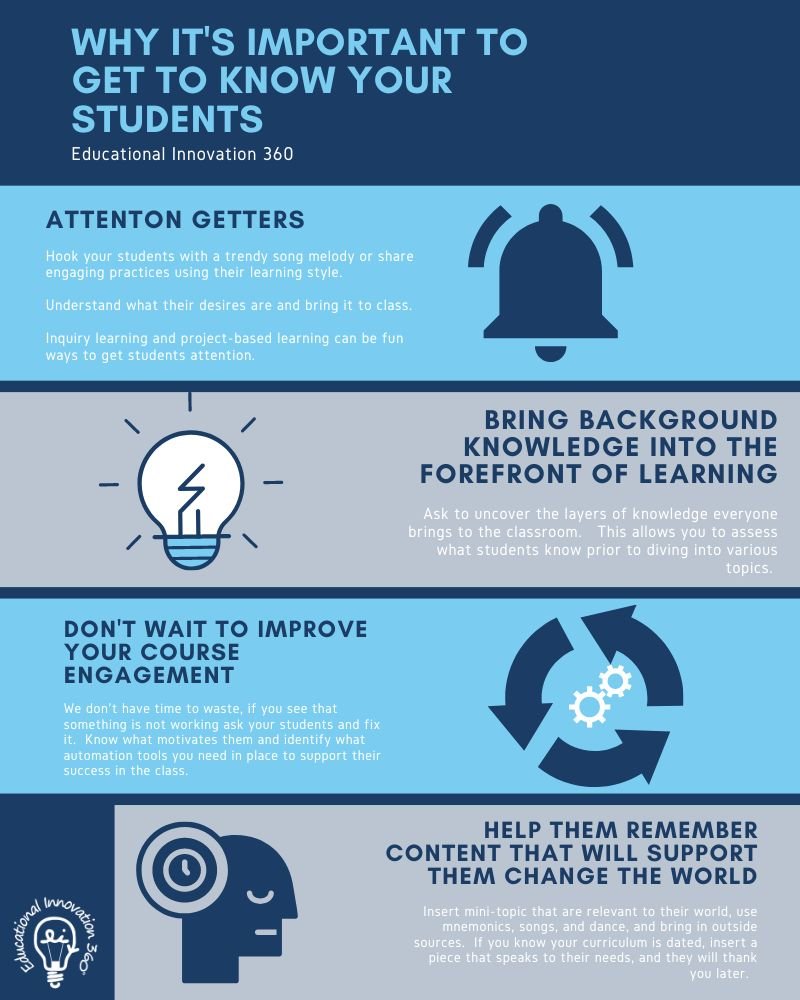Why Is It Important to Understand Students' Needs and Interests?
As educators, our primary goal is to facilitate learning and growth in our students (Bennett). In order to achieve this goal, it is crucial for us to understand our students' needs and interests. Every student is unique, with their own set of strengths, areas of support, and interests, and learning styles (Grant). When we take the time to get to know our students as individuals, we are better equipped to tailor our instruction to meet their needs. For example, some students may excel in visual or hands-on learning, while others may learn best through auditory or kinesthetic methods. By understanding these differences, we can incorporate a variety of teaching strategies to ensure that all students have the opportunity to succeed.
Ei360: Why it’s important
Do you understand what your students are interested in?
Additionally, when we take the time to understand our students' interests, we can make connections between the content we are teaching and their real-world experiences (Lange). This can help to make learning more engaging and relevant, as students are more likely to be motivated when they see the value in what they are learning. For example, if we know that a student is interested in a particular sport, we can use that as a context for teaching concepts related to physics or math.
What interventions are needed in your classroom?
Understanding our students' needs and interests also allows us to provide targeted support and interventions when necessary (Tomlinson). For example, if we notice that a student is struggling with a particular concept, we can provide additional resources or one-on-one support to help them master the material. Similarly, if we notice that a student is disengaged or unmotivated, we can work to identify the root cause of the problem and develop strategies to address it.
Here are five things teachers can do in the classroom to support student ’ needs and interests:
Conduct student surveys or interviews to get to know their interests and learning styles.
Offer a variety of learning activities and opportunities to cater to different learning preferences and strengths.
Incorporate students' interests and experiences into lesson plans and activities whenever possible.
Provide opportunities for student choice and autonomy in their learning, such as allowing them to choose a topic for a project or select from a menu of assignments.
Offer individualized support and feedback to students who are struggling, and celebrate their successes and achievements.
Do you take the time to get to know your students?
Finally, when we take the time to understand our students'’ needs and interests, we are better able to build positive relationships with them (Bennett). Students who feel seen and heard by their teachers are more likely to feel connected to their school and to be motivated to learn. This can have a ripple effect on their academic and personal success, as students who feel supported by their teachers are more likely to take risks, ask questions, and pursue their goals. When we take the time to get to know our students as individuals, we are better equipped to meet their needs, make learning more engaging and relevant, provide targeted support and interventions, and build positive relationships. By prioritizing this important work, we can help all students to succeed and thrive in school and beyond.
Citations:
Bennett, Jenna. “Why Understanding Student Needs and Interests Is Crucial to Effective Teaching.” Edmentum Blog, 27 Sept. 2021, www.edmentum.com/blog/why-understanding-student-needs-and-interests-crucial-effective-teaching.
Grant, Holly. “Why Understanding Your Students' Needs is Essential.” TeachThought, 27 Apr. 2020, www.teachthought.com/pedagogy/why-understanding-your-students-needs-is-essential/.
Lange, Christopher M. “Why Understanding Your Students' Needs Is the Key to Successful Learning.” EdSurge, 10 Jan. 2018, www.edsurge.com/news/2018-01-10-why-understanding-your-students-needs-is-the-key-to-successful-learning.
Tomlinson, Carol Ann. “The Importance of Knowing Your Students.” Association for Middle Level Education, 2008, www.amle.org/BrowsebyTopic/WhatsNew/WNDet/TabId/270/ArtMID/888/ArticleID/16/The-Importance-of-Knowing-Your-Students.aspx.

